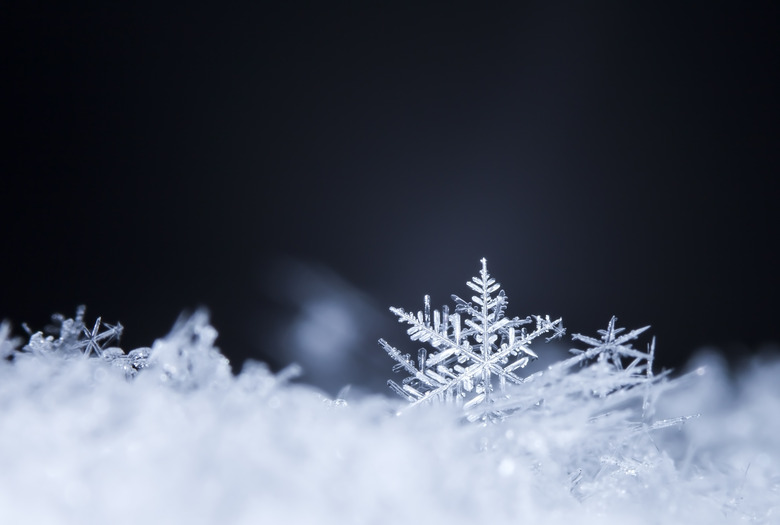What Happens To Chemical Bonds During Chemical Reactions
During chemical reactions, the bonds that hold molecules together break apart and form new bonds, rearranging atoms into different substances. Each bond requires a distinct amount of energy to either break or form; without this energy, the reaction cannot take place, and the reactants remain as they were. When a reaction is finished, it might have taken energy from the surrounding environment, or put more energy into it.
TL;DR (Too Long; Didn't Read)
Chemical reactions break and reform the bonds that hold molecules together.
Types of Chemical Bonds
Types of Chemical Bonds
Chemical bonds are bundles of electric forces that hold atoms and molecules together. Chemistry involves several different kinds of bonds. For example, the hydrogen bond is a relatively weak attraction involving a hydrogen-bearing molecule, such as water. The hydrogen bond accounts for the shape of snowflakes and other properties of water molecules. Covalent bonds form when atoms share electrons, and the resulting combination is more chemically stable than the atoms are by themselves. Metallic bonds occur between atoms of metal, such as the copper in a penny. The electrons in metal move easily between atoms; this makes metals good conductors of electricity and heat.
Conservation of Energy
Conservation of Energy
In all chemical reactions, energy is conserved; it is neither created nor destroyed but comes from the bonds that already exist or the environment. Conservation of Energy is a well-established law of physics and chemistry. For every chemical reaction, you must account for the energy present in the environment, the bonds of the reactants, the bonds of the products, and the temperature of the products and environment. The total energy present before and after the reaction must be the same. For example, when a car engine burns gasoline, the reaction combines the gasoline with oxygen to form carbon dioxide and other products. It doesn't create energy from thin air; it releases the energy stored in the bonds of molecules in the gasoline.
Endothermic vs. Exothermic Reactions
Endothermic vs. Exothermic Reactions
When you keep track of the energy in a chemical reaction, you will find out if the reaction releases heat or consumes it. In the previous example of burning gasoline, the reaction releases heat and increases the temperature of its surroundings. Other reactions, such as dissolving table salt in water, consume heat, so the temperature of the water is slightly lower after the salt dissolves. Chemists call heat-producing reactions exothermic, and heat-consuming reactions endothermic. Because endothermic reactions require heat, they cannot take place unless enough heat is present when the reaction starts.
Activation Energy: Kickstarting the Reaction
Activation Energy: Kickstarting the Reaction
Some reactions, even exothermic ones, require energy just to get started. Chemists call this the activation energy. It is like an energy hill that the molecules must climb before the reaction is set into motion; after it starts, going downhill is easy. Going back to the example of burning gasoline, the car engine must first make a spark; without it, not much happens to the gasoline. The spark provides the activation energy for the gasoline to combine with oxygen.
Catalysts and Enzymes
Catalysts and Enzymes
Catalysts are chemical substances that reduce the activation energy of a reaction. Platinum and similar metals, for example, are excellent catalysts. The catalytic converter in a car's exhaust system has a catalyst like platinum inside. As exhaust gases pass through it, the catalyst increases chemical reactions in harmful carbon monoxide and nitrogen compounds, turning them into safer emissions. Because reactions don't use up a catalyst, a catalytic converter can do its job for many years. In biology, enzymes are molecules that catalyze chemical reactions in living organisms. They fit into other molecules so reactions can take place more easily.
Cite This Article
MLA
Papiewski, John. "What Happens To Chemical Bonds During Chemical Reactions" sciencing.com, https://www.sciencing.com/what-happens-to-chemical-bonds-during-chemical-reactions-13710217/. 19 March 2018.
APA
Papiewski, John. (2018, March 19). What Happens To Chemical Bonds During Chemical Reactions. sciencing.com. Retrieved from https://www.sciencing.com/what-happens-to-chemical-bonds-during-chemical-reactions-13710217/
Chicago
Papiewski, John. What Happens To Chemical Bonds During Chemical Reactions last modified August 30, 2022. https://www.sciencing.com/what-happens-to-chemical-bonds-during-chemical-reactions-13710217/
